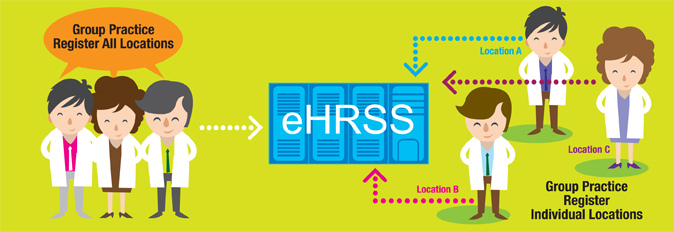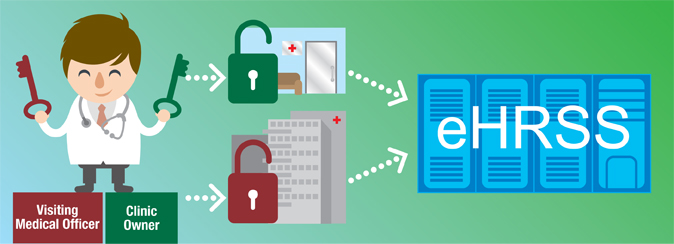|
The Public-Private Interface–Electronic Patient Record Sharing Pilot Project (PPI-ePR) will be decommissioned after the implementation of the Electronic Health Record Sharing System (eHRSS). Existing PPI-ePR participants and healthcare providers (HCPs) can migrate to the new system with ease.
|
| |
|
Since the launch of the PPI-ePR by the Hospital Authority in 2006, more than 460,000 patients and 3,400 private healthcare professionals (HCProf) have enrolled in the programme. It serves as a pilot and provides a backbone for the development of the territory-wide eHRSS, and will be replaced when the latter comes into operation. By then, two-way eHR sharing will be realised to facilitate better collaboration between public and private healthcare services, leading the way to a new healthcare delivery paradigm in Hong Kong.
|
 |
| |
|
How can patients migrate from the PPI-ePR to the eHRSS? |
| |
|
|
|
Joining the eHRSS is voluntary and free-of-charge. |
|
|
|
Patients participated in the PPI-ePR will receive an invitation letter with a reference number and a SMS message sent to their mobile phones with a security code in the first quarter of 2016. |
| |
|
|
| |
|
 |
| Receive an invitation letter with a “Reference Number” |
|
A SMS message sent to their mobile phones with a security code |
|
| |
|
|
|
|
|
They can register with the eHRSS through ONE of the following methods: |
| |
|
|
| |
|
 Online registration at the designated website Online registration at the designated website |
| |
|
|
| |
|
 |
| |
|
|
| |
|
 Phone registration by calling the designated hotline Phone registration by calling the designated hotline |
| |
|
|
| |
|
 |
| |
|
|
| |
|
 Complete the reply slip enclosed in the invitation package and return it by fax or mail Complete the reply slip enclosed in the invitation package and return it by fax or mail |
| |
|
|
| |
|
 |
| |
|
|
|
| What are the benefits to patients? |
| |
| The eHRSS allows two-way viewing of medical records in both the public and private healthcare sectors, bringing to patients such benefits as: |
|
|
|
All health-related information contained in a secure record in electronic format |
|
|
|
More efficient and effective use of diagnostic tests |
|
|
|
Timely treatment |
|
|
|
Improved accuracy of diagnosis and disease management |
|
| |
 |
| |
| How can HCPs migrate to the eHRSS? |
| |
|
|
|
eHRSS registration is HCP-based, i.e. on organisational basis. |
|
|
|
HCPs can apply by sending a completed registration form to the eHR Registration Office together with the required supporting documents. |
| |
|
|
| |
|
|
| |
|
|
|
| Are there any other points to note regarding registration? |
| |
|
|
|
A clinic owned by a doctor has to register as a HCP, with the doctor registering as a HCProf under his clinic. |
|
|
|
A visiting doctor/medical officer who wants to access the eHRSS in another HCP such as a private hospital needs to register as a HCProf under that private hospital. |
|
|
|
Group practice |
| |
|
|
|
|
can register all or just individual healthcare service locations |
|
|
|
is responsible for the administrative arrangements, supervision, monitoring of eHR access and sharing by its HCProfs at the registered locations |
|
|
| |
 |
|
Group practice can register all or individual service locations |
|
|
|
HCProfs |
| |
|
|
|
|
can register with the HCP they are working for if possessing valid professional registration status |
|
|
|
will be granted access right to the eHRSS by the HCP according to the role-based access control mechanism |
|
|
| |
 |
|
The access right to the eHRSS of HCProfs will be granted by the HCP according to the role-based access control mechansim |
| |
| What are the benefits to HCPs? |
| |
| The eHRSS can facilitate communication of clinical information. Benefits to HCPs include: |
|
|
|
Health record always made available online for the provision of healthcare services |
|
|
|
Improved availability and transparency of information shared between the public and private sectors |
|
|
|
Efficient clinical practice with reduced errors and less repeated tests |
|
|
|
Efficiency gained by avoiding the need to store, collate and transfer paper records |
|
| |
 |
| |
| What will happen to the PPI-ePR Enrolment Outlets afterwards? |
| These outlets will be converted into eHR Registration Centres to provide registration-related services to patients. |
| |
|
|

